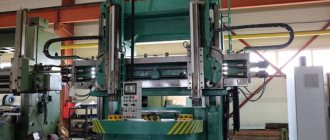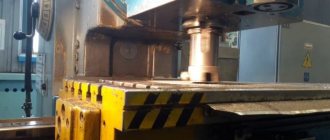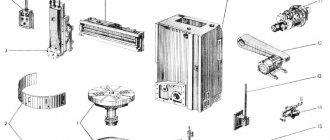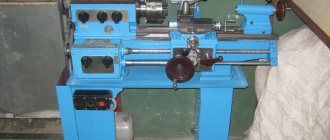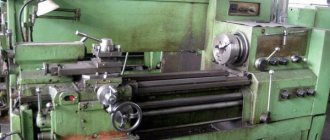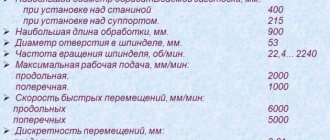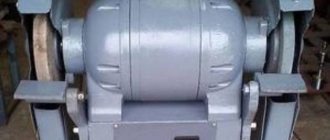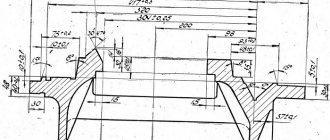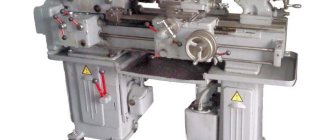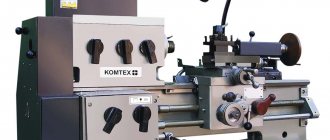Specifications
Full technical specifications are described in the instruction manual.
- The installed workpiece can have a maximum of the following parameters in terms of weight, height and diameter: 4000 kilograms, 1000 and 1250 millimeters, respectively.
- 11200 is the diameter of the platform itself.
- 5-250 rpm – angular speed for the faceplate.
- The tool feed rate is 0.03-12.5 revolutions per minute. In total, this and the previous indicators have up to 18 steps.
- 5-1800 – speed according to installation movements.
- The power of the main movement is 30 kW.
- 16.5 is the total mass for installation.
How do rotary lathes work?
The structure rests on a hollow post cast from cast iron in a vertical position. All other components connect to this part.
Main node devices
There are not many components in the desktop:
- Faceplate.
- The previous part is installed complete with the spindle.
- A mandatory addition is supports in a cast iron housing with bearings.
- Drive device.
The design is equipped with cylinder-shaped, roller-type bearings. They are mounted to center the platform and control radial forces during cutting. The radial clearance parameters in the supports are individually selected. To do this, using adjusting nuts, tighten the inner rings, which have a conical surface.
Frictional forces and the weight of the workpieces create an additional load that is transmitted to the ring guide responsible for sliding. This part has central lubrication. A cylindrical helical gear imparts rotational force to the faceplate. The force itself is directed from the drive shaft. The latter is tied to the main drive responsible for movement.
Speed control box
Popularly, such a knot is also called the “carousel pig”. Performs a function related to the transmission of torque, starting from the drive motor and ending with the spindle on the desktop.
In addition, the part allows you to set the required peripheral speed for the spindle itself.
In total, the mechanism has up to 6 shafts. They use special gears to move power from one component to another. The components maintain constant engagement with each other. But the gears sit loosely on the shafts, there is no rigid clutch. The rotation acquires a certain frequency due to the commutation of couplings in the electromagnetic circuit. There are a total of 10 functions in the box that can be customized. Everything happens remotely.
Workpieces and faceplates are characterized by significant inertial masses, which increase the starting current by the time the engine starts. The platform is being accelerated in steps to reduce such risks. Switching on can be carried out in 2,3 or 4 stages, it all depends on the given speed.
Clutches can be switched during operation. Therefore, when turning surfaces, the speed remains constant.
The platform has a limited angular speed depending on the parameters of the workpiece that is currently being processed. For example, it is permissible to set no more than 80 revolutions with masses of 3.2 tons.
Vertical support unit
The part is equipped with a turret with 5 positions. It is needed for the tool; it moves in two planes:
- Vertically.
- Horizontally.
The first version of the scheme is provided by guides supporting the caliper. The second involves support on traverses and crossbars. Characteristic is the movement of the part itself vertically, along the rack. The gearbox is mounted on a traverse and is used as a displacement drive.
Vertical movement has its own characteristics:
- The movement itself occurs due to an independent drive, which has its own motor.
- The worm mechanism allows you to change positions if necessary. It comes from a separate electric drive.
- The caliper easily tilts up to 45 degrees in both directions.
- Thanks to this device, processing conical parts is not difficult.
Side caliper
Has the following features:
- Availability of 4-position tool holder.
- Duplication of orthogonal movements of the vertical support device.
The force of movement is transmitted by a gearbox mounted on the end of the mechanism. Why is it necessary to duplicate the movements of the second node? Processing accuracy increases when using such solutions. The instrumentation system operates with reduced elastic deformations. The implementation has several variants of schemes, which are selected individually for each situation. The central holes are processed using a vertical knot.
Types of machines
Depending on the design features there are:
- Single-column vertical turning lathe (1516, 1512, 1531M and other models), which has a relatively small faceplate (no more than 1600 mm). Accordingly, such a machine is designed for processing oversized workpieces with a diameter of up to 1500 mm.
- Two-column rotary lathe (1525, 1L532, 1553 and other models). Machines of this type can process very large workpieces, as they have faceplates up to 25,000 mm in size. In addition, such units have higher manufacturability and processing accuracy.
Purpose and scope
The numbers in the marking have the following interpretation, if we rely on the domestic classifier:
- 1 – assignment to a specific group of equipment. In this case it is turning.
- 5 – machine type. It's a carousel.
- 12 – characteristic describing the dimensions. 1250 millimeters is the maximum part size for processing.
The name “carousel” has its own history. Essentially, the term refers to how the installation is designed. The main parts include the faceplate with clamping elements. Rotation around a vertical axis makes the device similar to the rides of the same name. The lathe type of machine is the closest in properties to its competitors. They differ in a spindle with a traditional horizontal arrangement. The passport confirms this.
The purpose of both types of devices is turning parts with a short length. But it is the carousel variety that has a wide range of advantages.
- High-quality fastening of components and parts.
- Convenient loading of workpieces.
- The spindle is not subject to bending forces.
- Processing may take longer. 1 – parameter of the relationship between height and diameter.
Among the disadvantages, possible difficulties with chip removal are noted. Diametric measurements also turn out to be inconvenient for many.
Opportunities from a technological point of view
The main purpose of rotary machines is to process relatively flat parts with a round configuration. Among the possible preparations:
- Gears.
- Wheel installations.
- Flywheels.
- Lids.
- Flanges.
- Disks.
The installation uses standard tools, including reamers, countersinks, drills, heads with cutters, and the like. The main technological operations for the device include:
- Making holes using a rod tool.
- The function of boring through and stepped holes.
- Cutting grooves in the shape of a circle.
- Grinding of ends, ledges.
- External turning of parts in the shape of a cone or cylinder.
The range of operations performed expands with the addition of special equipment:
- Lapping, rolling using rollers.
- Sanding, superfinishing.
- Thread cutting.
- Deep drilling.
- Processing of nonlinear surfaces, including spherical ones.
Adjustable clamps make it easier to secure workpieces if necessary. The same goes for the cams. Small parts are installed in additional self-centering chucks.
What other features does the equipment have?
The following technical indicators of the units should be the main ones for buyers.
- Section of the washer.
- The speed at which the crossbar moves, specified for machines with two posts.
- Maximum distance of movement of supports, horizontal and vertical.
- Section with the height of the part to be processed.
- The number of revolutions of the faceplate.
- The angle for tilting the faceplate.
- Number of speeds.
- General power.
You can download the machine passport here.
When parts are processed by rotary mechanisms, high speeds are typically maintained. Serious cantilever loads do not harm the spindle; the use of a faceplate prevents damage. This part is placed on the structure in a special way to achieve the best result.
Classification
Vertical lathes can be divided according to certain criteria.
By purpose
The purpose of the devices can be different: universal machines are designed to perform many operations, special machines have a narrower focus.
Universal
Universal lathes usually have one stand. Models of universal machines have their own sizes. They are determined by the diameter of the workpiece. The universal model can be used to perform almost any turning operation.
REFERENCE! Each subsequent model of the machine allows you to install a workpiece 1.26 times larger than the previous one. Accordingly, the diameters of the workpieces can be 800, 1000, 1250, 1600 mm and so on. In the same way, the height of the workpiece increases exponentially.
Specialized
Specialized lathes are made on the basis of universal ones, but differ in the following:
- increasing or decreasing the processing height;
- number and design of calipers;
- additional drive heads;
- devices for the production of special works.
More and more of these machines are equipped with CNC systems.
By the number of support points
Also, rotary-type machines can be distinguished by the number of support points. They may have one or two posts.
Single post
A machine with one rack often has a numerical control. On versions with one stand, parts with a diameter of no more than 150 cm are finished. Conical surfaces are also processed on them. Single-column models have an auxiliary side support equipped with a universal holder.
Double post
Two racks increase the stability and rigidity of the structure, so very heavy, large parts are processed on such machines. Between the two racks there is a portal along which a crossbar with two supports moves.
By number of calipers
The difference between machines is determined by the presence of supports. A model may have one or more of these elements. This determines what kind of processing the parts will be subjected to.
With one
Depending on the type of processing, the device can be equipped with one or more supports. The version with one caliper has a narrower specialization.
With several
The ability to process parts is significantly expanded with the use of multiple supports.
By type of spindle head
The equipment may differ in the type of spindle head: the number of cutting tools and the ability to process parts depend on this.
With regular
A vertical lathe sometimes has a conventional spindle head designed for one cutter.
With a revolver
Modern devices are becoming more widespread. The advent of the turret made it possible to use several cutters. The rotation of the turret head can be either horizontal or vertical. The cutting tools are installed one by one in the head and are sequentially put into operation.
By type of control of working movements
The type of machine control is very important. With manual control, the operator must be very careful, while the use of numerical control practically eliminates human presence.
Manual
The machine may have manual control. They are used for the manufacture of simple workpieces or their rough processing.
CNC
But CNC machines are becoming more common. They can use a greater number of operations, have high speed and the best processing accuracy.
Domestic models of the 1512, 1516 and 1525 series
The Machine Tool Plant named after G. M. Sedin was the institution that was considered the main one among manufacturers during the Soviet era. In 1953 the first carousel unit appeared. Design in this direction was carried out by company specialists.
After that moment, rotating lathes became the main specialization of the plant. The machines of this enterprise are still actively used in many areas of industry. The 1512 and 1516 series are the most widely used. These are universal-purpose devices, with one rack. Purpose – small-scale processing of parts made of non-ferrous and ferrous metals.
The functionality of the machine is enough to perform any type of turning work.
Some variants of the devices had faceplates of a self-centering design. Due to this, the technical capabilities of the units began to expand.
Machine 1525 is a two-column type of equipment that was produced by the same Sedin plant. Distinctive features are reversible movements of the faceplate. There are also two upper rotary calipers. With the help of two clutches, the owner can easily select rotation frequency intervals in a given case. The speed at which the motor operates is adjusted by a transistor converter. For this, a stepless circuit is used.
The above types of machines are complemented by CNC if necessary. Then the devices operate on the basis of a software package.
Popular foreign-made models
Despite the high technology of domestic CNC lathes, many enterprises, unfortunately, are forced to switch to more modern models. There are many cars on the market from foreign manufacturers. The most popular are the Chinese machines CA5112E, C5225E, C5231, etc. Most of these machines are single-column, having powerful drives from 20 to 55 kW. Some machines of these models are equipped with a simplified CNC system with digital display. They are designed for both roughing and finishing machining of workpieces made of ferrous metals and other alloys. They pay off well in individual and mass production.
The Swiss CNC lathe ZENITECH is also considered popular. As you can see, this country produces not only luxury watches, but also similar units that have high limiting faceplate frequencies (up to 315 rpm). In addition, the material and reliable design of the guides give the vertical console excellent stability, which has a positive effect on machining accuracy.
It is also worth mentioning the German VDM machines (models 800, 1600, 1250 and 2600). There is no need to talk about the quality of this country’s products. VDM machines are made of high quality, reliable and have decent technical characteristics. Despite the fact that these are single-rack devices, they are equipped with powerful motors up to 37 kW. In addition, some models have in their functionality accelerated strokes of the side and top calipers (no more than 1800 mm/min.) and relatively high speeds (from 0.8 to 86 mm/min. along the Z, X axis and 440 mm/min. along the W axis).
The cost of foreign-made machines, of course, is significantly higher than any domestic machine, but quickly pays off in the first few years.
A little about imported analogues
Chinese C series machines have become very popular in the modern market:
- Two-rack equipment with designations 5240, 5231, 5250, 5263Q. The units have approximately the same characteristics as the models produced by the domestic plant named after Sedin. The processing of metal parts is guaranteed to be accurate. Performs most types of turning work.
- Machines with one rack and power of 22-45 kW. They are designated as 5131, 5125, 5110, 5123, 5116. Ease of use and high level of reliability are the main advantages of such equipment. The equipment is equipped with servomotors to increase productivity.
ENCE GmbH is another foreign plant that supplies machine tools to the territory of the Russian Federation. Their quality is higher compared to previous models, but the cost increases accordingly. The units are sold in several series; any buyer will choose an option with suitable characteristics.
CNC models
CNC lathes do not have a side support, since the design of the support is significantly more complicated.
Many people prefer to manufacture the required parts on this equipment for the following reasons:
- The control unit allows you to set the number of revolutions of the faceplate. In this case, the operator can set parameters with high accuracy.
- For work, tools can be installed whose cutting edge is made of wear-resistant steel. Due to this, you can significantly speed up the cutting process.
- Processing is often carried out automatically under computer control, which greatly simplifies the use of thread-cutting models. Indeed, in many cases, it is the error made by the operator that becomes the cause of the defect.
- To use such equipment, it is enough to have a technologist on staff who must write a program to obtain certain parts.
- The accuracy of the resulting dimensions can be very high. The machine of this group can be boring or universal, designed to perform other operations.
- The electrical circuitry of modern machines can significantly reduce electrical costs. For this purpose, electric motors with high efficiency and efficiency are installed. Like conventional models, the CNC version is equipped with several electric motors, each responsible for performing certain tasks.
CNC turning lathe
In general, we can say that the future of various manufacturing industries lies with CNC machines. They have increased productivity and allow the production of high-precision parts. At the same time, the dimensions of the structure are reduced every year, and the processing area is covered with a protective casing.
